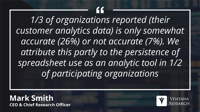I am happy to share some insights from our latest Value Index research, which rates how well vendors’ offerings meet buyers’ requirements in seven categories, five relevant to the product (adaptability, capability, manageability, reliability and usability) and two related to the vendor (TCO/ROI and vendor validation). The Ventana Research Value Index: Sales Performance Management 2019 is the distillation of a year of market and product research efforts by Ventana Research. Drawing on our...
Read More
Topics:
Sales,
Customer Experience,
Office of Finance,
Analytics,
Contact Center,
Data,
Sales Performance Management,
Financial Performance Management,
Digital Technology,
Digital Commerce,
Predictive Planning,
Conversational Computing,
collaborative computing,
mobile computing,
Subscription Management,
agent management,
intelligent sales,
AI & Machine Learning
Configure, price and quote (CPQ) software has been around for decades. Lately, I’ve been using the term “Dynamic CPQ” to apply to a variant of this software category that explicitly aims to produce a quote that optimizes the trade-off between the profitability of a deal and the probability of closing a sale. Dynamic CPQ software is a hybrid of price and revenue optimization (PRO) software and CPQ, providing companies with the ability to better execute their market share and pricing strategies....
Read More
Topics:
Customer Experience,
Office of Finance,
Data Preparation,
Information Management,
Sales Performance Management,
Financial Performance Management,
Price and Revenue Management,
robotic finance,
revenue and lease accounting,
sales enablement
Customer analytics have never been more important, but effectively creating and managing them is not easy. The data that’s required to achieve visibility into all customer activity involves many applications and systems and it’s a challenge to ensure the data used is accurate and consistent. Even once data is assembled, organizations often struggle to apply analytics to create the metrics that best represent an understanding of the past and, more importantly, the path to the future.
Read More
Topics:
Customer Experience,
Voice of the Customer,
embedded analytics,
Analytics,
Business Intelligence,
Collaboration,
Data Governance,
Data Lake,
Data Preparation,
Information Management,
Contact Center,
Data,
Digital Technology,
Digital Commerce,
blockchain,
natural language processing,
Intelligent CX,
Conversational Computing,
collaborative computing,
Subscription Management,
agent management,
extended reality,
AI & Machine Learning
Ensuring that the sales organization contributes as fully as possible to the success of the organization — to revenue, growth, prof itability and the overall customer experience — requires not only dedication but effective strategy and planning. A well-developed strategy and plan to utilize current and future sales talent is essential for the best possible sales performance. To carry out this mission, organizations need a set of coordinated sales-related activities, processes and systems that...
Read More
Topics:
Sales,
Customer Experience,
Office of Finance,
Analytics,
Contact Center,
Data,
Sales Performance Management,
Financial Performance Management,
Digital Technology,
Digital Commerce,
Predictive Planning,
Conversational Computing,
collaborative computing,
mobile computing,
Subscription Management,
agent management,
intelligent sales,
AI & Machine Learning
Today’s intense competition requires that companies know as much as they can about their customers in order to anticipate their needs and deliver a superior customer experience. However, many organizations struggle to do this well. Implementing initiatives to improve customer value across any department or process involving customers requires both in-depth visibility into current operations and excellent metrics.
Read More
Topics:
Customer Experience,
Voice of the Customer,
business intelligence,
embedded analytics,
Analytics,
Collaboration,
Data Governance,
Data Preparation,
Internet of Things,
Contact Center,
Data,
Digital Commerce,
blockchain,
natural language processing,
data lakes,
Intelligent CX,
Conversational Computing,
collaborative computing,
mobile computing,
Subscription Management,
agent management,
extended reality,
AI & Machine Learning
The traditional office of finance has five main organs: accounting keeps the books; financial planning and analysis (FP&A) analyzes performance and manages the forward-looking activities of the company such as planning, budgeting and forecasting; corporate finance raises outside money; treasury takes care of the cash and bank accounts, and tax. The modern office of finance requires a sixth: Finance IT (FIT).
Read More
Topics:
Office of Finance,
Analytics,
Financial Performance Management,
Price and Revenue Management,
Digital Technology,
Operations & Supply Chain,
ERP and Continuous Accounting,
blockchain,
robotic finance,
Predictive Planning,
Conversational Computing,
revenue and lease accounting,
collaborative computing,
Subscription Management,
AI & Machine Learning
Managing sales processes and resources without careful planning is a recipe for failure. Effectiveness in sales starts with planning that involves the full range of stakeholders. This planning should involve a systematic process, incorporate all relevant information and be supported by capable software designed for this purpose. Furthermore, everyone who participates in sales-related activities, including those dealing with quotas, territories and resources, should be providing input for the...
Read More
Topics:
Sales,
Product Information Management,
Sales Performance Management,
Digital Commerce,
Subscription Management,
intelligent sales
I am happy to share some insights on NOVAtime Technology drawn from our latest Value Index research, which provides an analytic representation of our assessment of how well vendors’ offerings meet buyers’ requirements. The Ventana Research Value Index: Workforce Management 2019 is the distillation of a year of market and product research efforts by Ventana Research. We utilized a structured research methodology that includes evaluation categories designed to reflect the breadth of the...
Read More
Topics:
Human Capital Management,
Workforce Management
I am happy to share some insights on Reflexis drawn from our latest Value Index research, which provides an analytic representation of our assessment of how well vendors’ offerings meet buyers’ requirements. The Ventana Research Value Index: Workforce Management 2019 is the distillation of a year of market and product research efforts by Ventana Research. We utilized a structured research methodology that includes evaluation categories designed to reflect the breadth of the real-world criteria...
Read More
Topics:
Human Capital Management,
Workforce Management
A quarter century ago the “fast, clean close” became a key measure of a finance and accounting department’s effectiveness. Since then there has been general agreement that companies should be able to close their books within a business week. Our research on the accounting close has consistently shown that companies with very similar characteristics (measured in terms of revenue, number of employees, location and industry) vary considerably in the number of days it takes them to complete their...
Read More
Topics:
Office of Finance,
Financial Performance Management,
ERP and Continuous Accounting,
robotic finance
Having effective analytics enables businesses to understand far better than ever before the data they’re collecting, and to do so in greater volumes and more forms. These new capabilities are especially relevant to sales organizations. When applied to sales data, analytics can help sales teams achieve quotas and forecast more consistently, as well as understand the impacts of incentives and maximize the potential of territories, all of which help improve sales performance. These benefits...
Read More
Topics:
Customer Experience,
Voice of the Customer,
business intelligence,
embedded analytics,
Analytics,
Collaboration,
Data Governance,
Data Preparation,
Information Management,
Internet of Things,
Contact Center,
Data,
Digital Technology,
Digital Commerce,
blockchain,
natural language processing,
data lakes,
Intelligent CX,
Subscription Management,
agent management,
AI & Machine Learning
I am happy to share some insights on Infor drawn from our latest Value Index research, which provides an analytic representation of our assessment of how well vendors’ offerings meet buyers’ requirements. The Ventana Research Value Index: Workforce Management 2019 is the distillation of a year of market and product research efforts by Ventana Research. We utilized a structured research methodology that includes evaluation categories designed to reflect the breadth of the real-world criteria...
Read More
Topics:
Human Capital Management,
Workforce Management
I am happy to share some insights on Workday drawn from our latest Value Index research, which provides an analytic representation of our assessment of how well vendors’ offerings meet buyers’ requirements. The Ventana Research Value Index: Workforce Management 2019 is the distillation of a year of market and product research efforts by Ventana Research. We utilized a structured research methodology that includes evaluation categories designed to reflect the breadth of the real-world criteria...
Read More
Topics:
Human Capital Management,
Workforce Management
Human resources and recruiting departments, and most job candidates, are well aware that we are firmly in a seller’s market when it comes to finding and hiring high-quality talent. Primary reasons for this include record low unemployment, the need to fill a variety of digital-age jobs across all industries that did not exist a few years ago and organizations competing fiercely to make their value proposition to candidates more attractive. This emphasis on effectively engaging candidates to...
Read More
Topics:
Human Capital Management,
Recruiting,
Talent Generation,
Talent Management,
candidate engagement


















